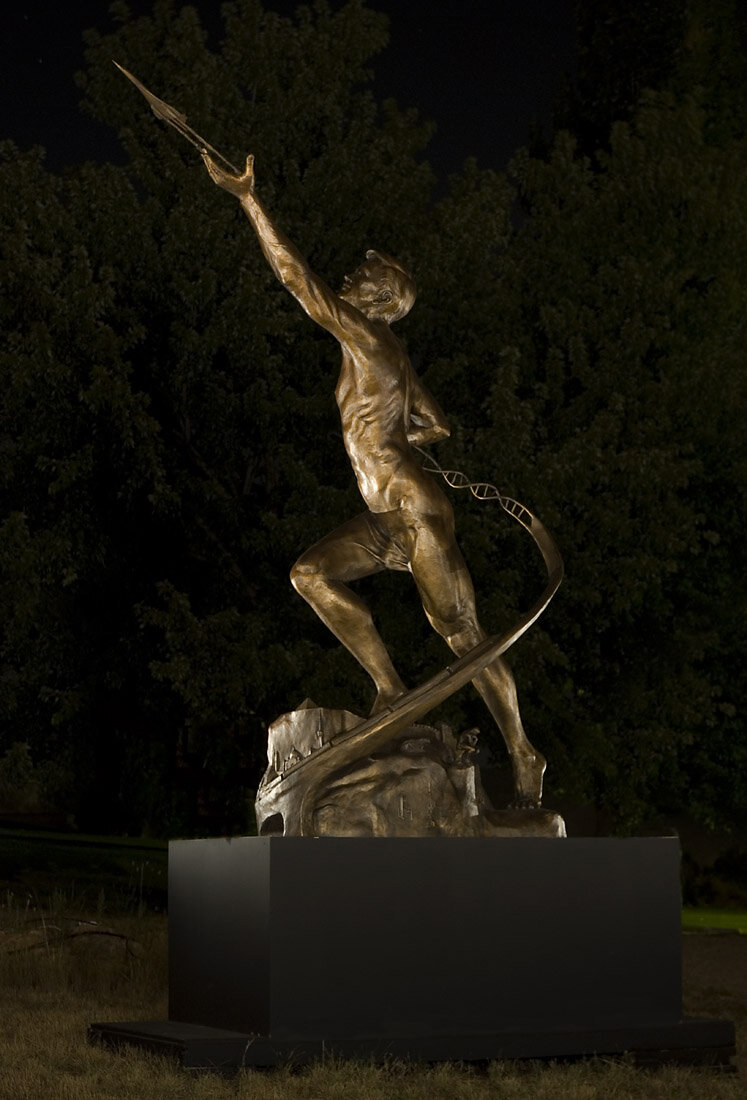
“Power of Thought”
Creating Living Bronze
The journey of humanity—from the first wheel to the moon and beyond.

“My work can beautify a space and offer a focal point with a message that unifies an institution’s understanding of its mission.”
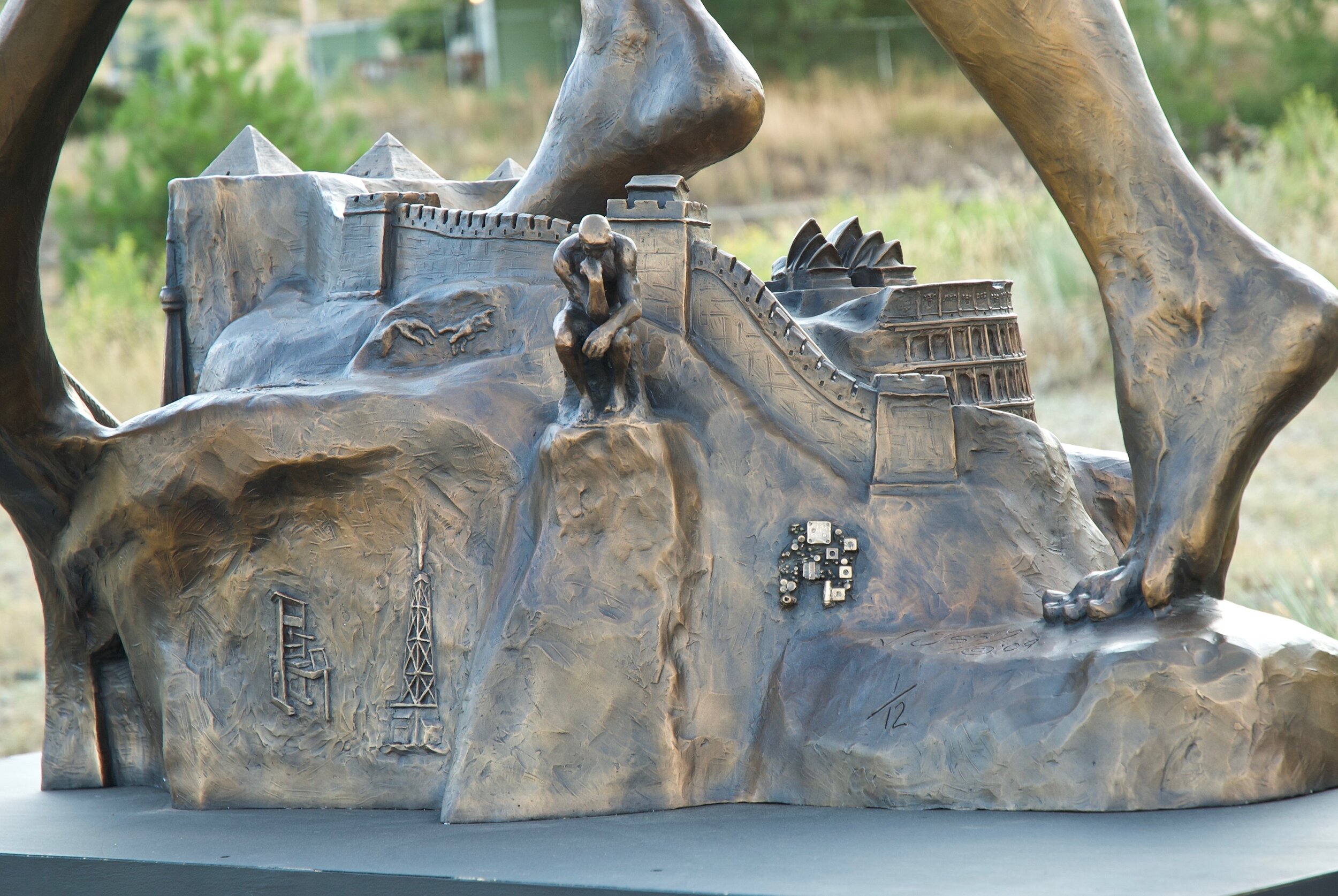
“Power of Thought”
For a limited time, Victor’s featured creation, “Power of Thought,” is available for purchase in various sizes and customizations. At first glance, the bronze sculpture depicts a powerful masculine figure, but look closer and you’ll discover 25 intricate details that tell stories about the human journey. For example, the athletic male figure’s raised left arm is releasing the Wright flier followed by the supersonic transport with its sleek body and elegant wings.
Victor was inspired to create “Power of Thought” after reflecting on the grand human achievements made throughout the millennia—and particularly the powerful roles individuals have played in creating a society where we can carry vast information and power in the palms of our hands.
“Power of Thought” is a visual recording of humankind’s history on Earth.


“‘Power of Thought’ reminds us of the value of the visionaries, the dreamers, the individuals whose singular ideas can change the world for the better.”
What is “Power of Thought”?
“Power of Thought” is inspired by the human accomplishments throughout centuries that began with a single thought. This sculpture is an acknowledgment and a celebration of the contemplation that has led men and women to expand the human experience.
Below the masculine-sculpted figure are representations of architectural, engineering, scientific, and artistic achievements that include:
Jordan’s Petra
The Roman Colosseum
Sydney’s Opera House
The Hoover Dam
The Egyptian pyramids
Shakespeare
Swan Lake
Beethoven’s 5th Symphony
Taj Mahal
Toronto’s CN Tower
The Great Wall of China
Michelangelo's “Creation of Adam”
Gutenberg's press
An oil derrick
Rodin’s “The Thinker”
A 1964 Zenith transistor radio
Edison’s first light bulb
Neil Armstrong’s footprint on the surface of the moon

“‘Power of Thought’ is intended to inspire others, particularly younger generations, to think contextually about their existence, what previous generations have accomplished, feel gratitude for the importance and the contribution of the individual and for where we are now, and consider how they might positively affect the human condition.”
Featured Sculpture: “Power of Thought”
Victor Issa’s provocative and inspiring artistic creation is titled “Power of Thought.” It is a limited-edition bronze that depicts a masculine figure and symbolizes the historic role individual visionaries play in the advancement of knowledge through the power of the human mind.
The sculpture is available for order in three sizes and can be customized for individual institutions and organizations.
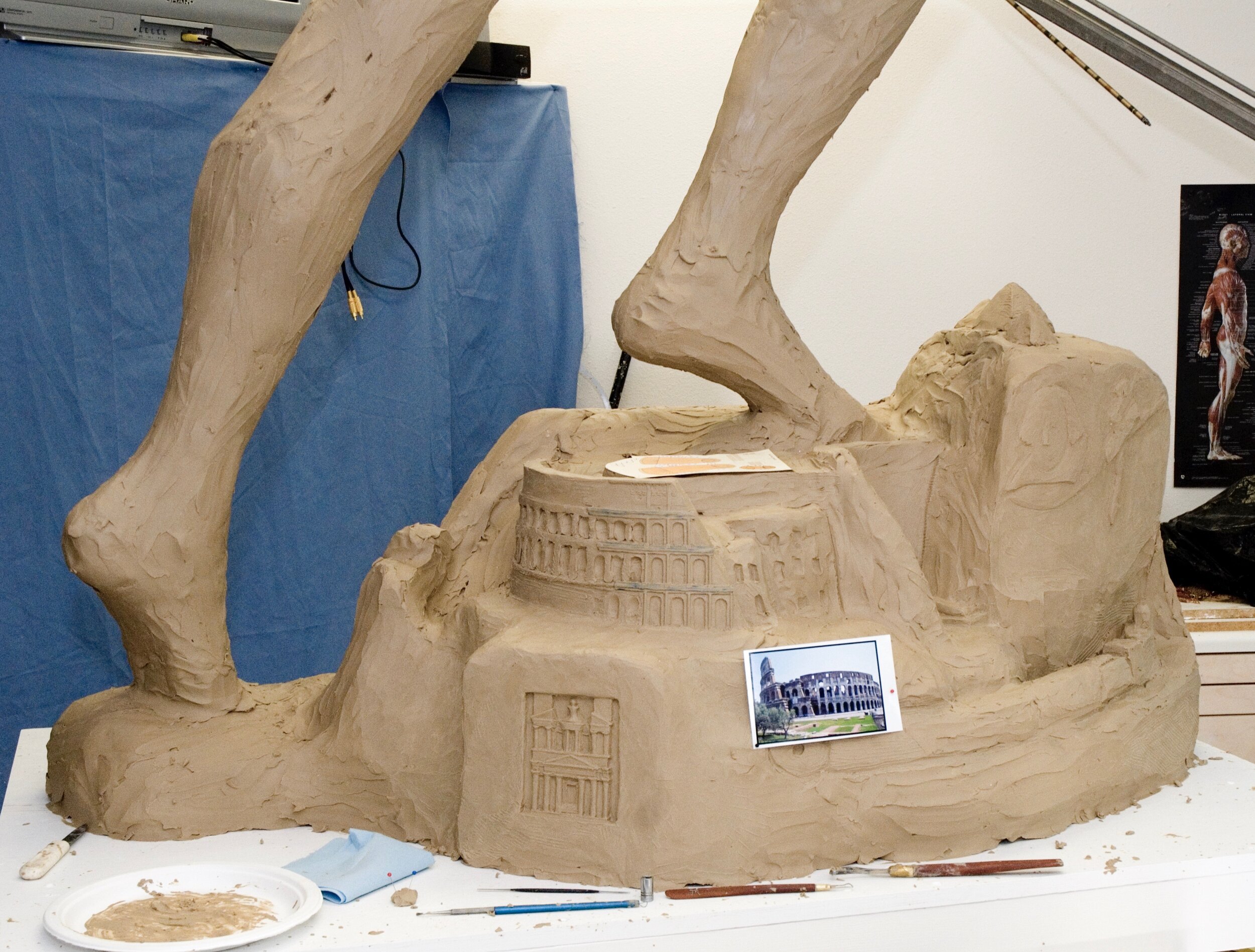
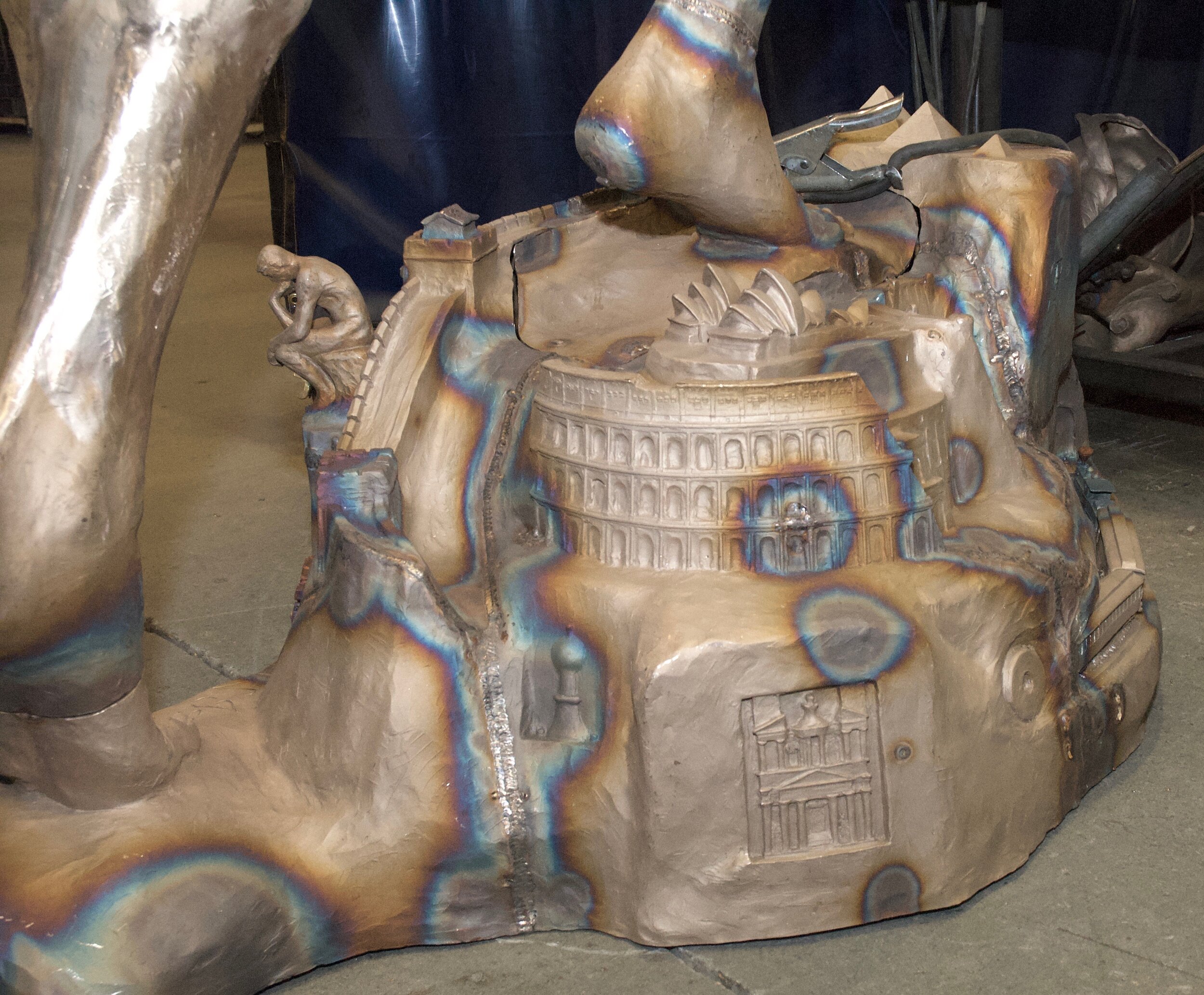
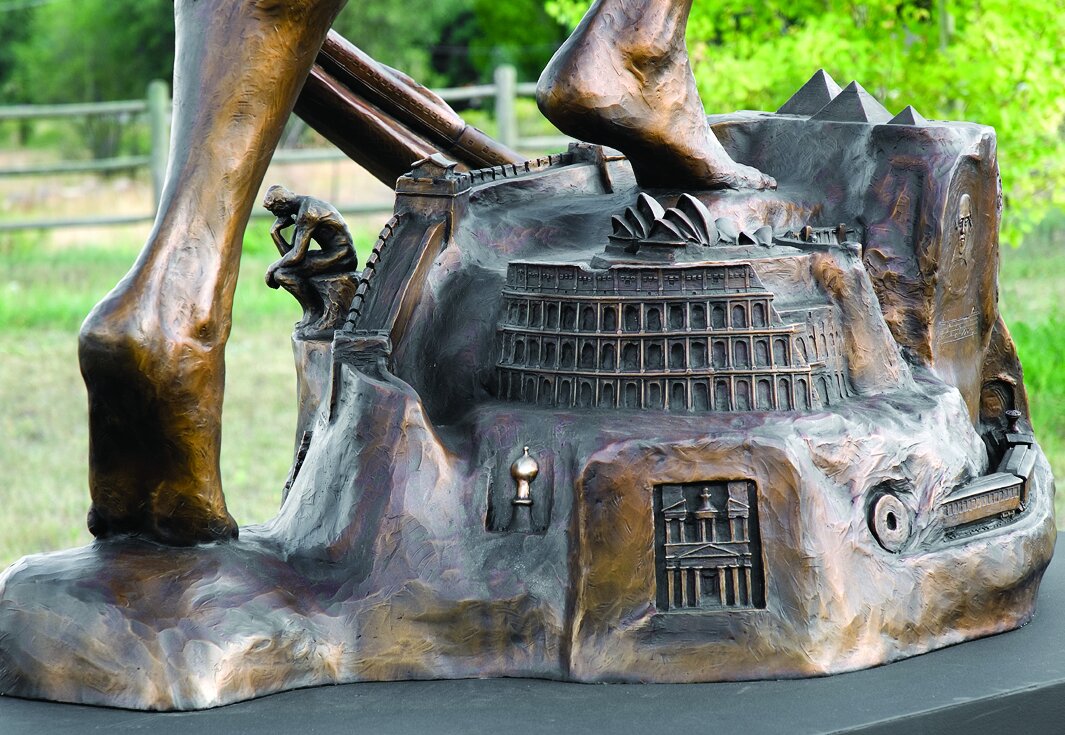
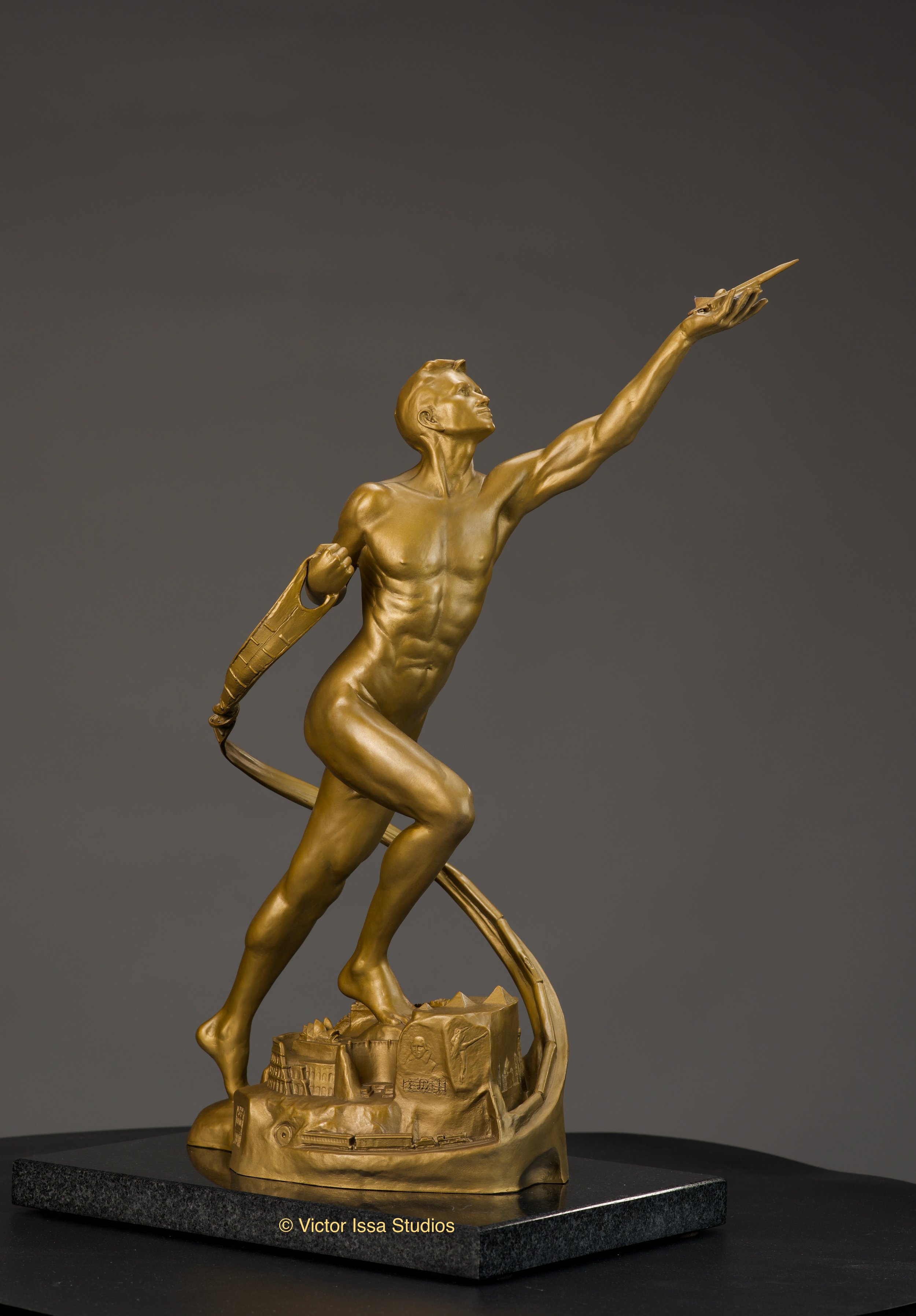
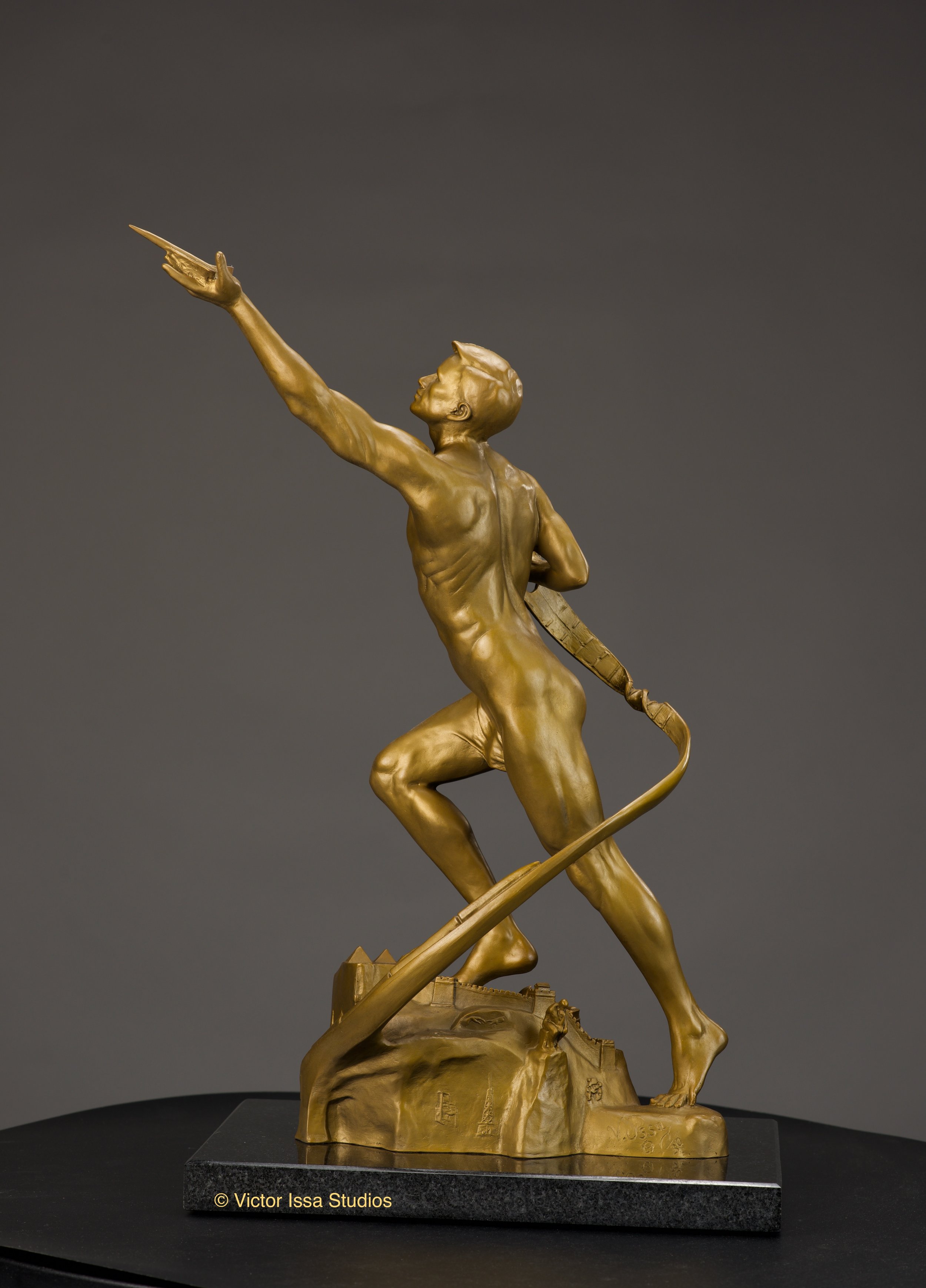
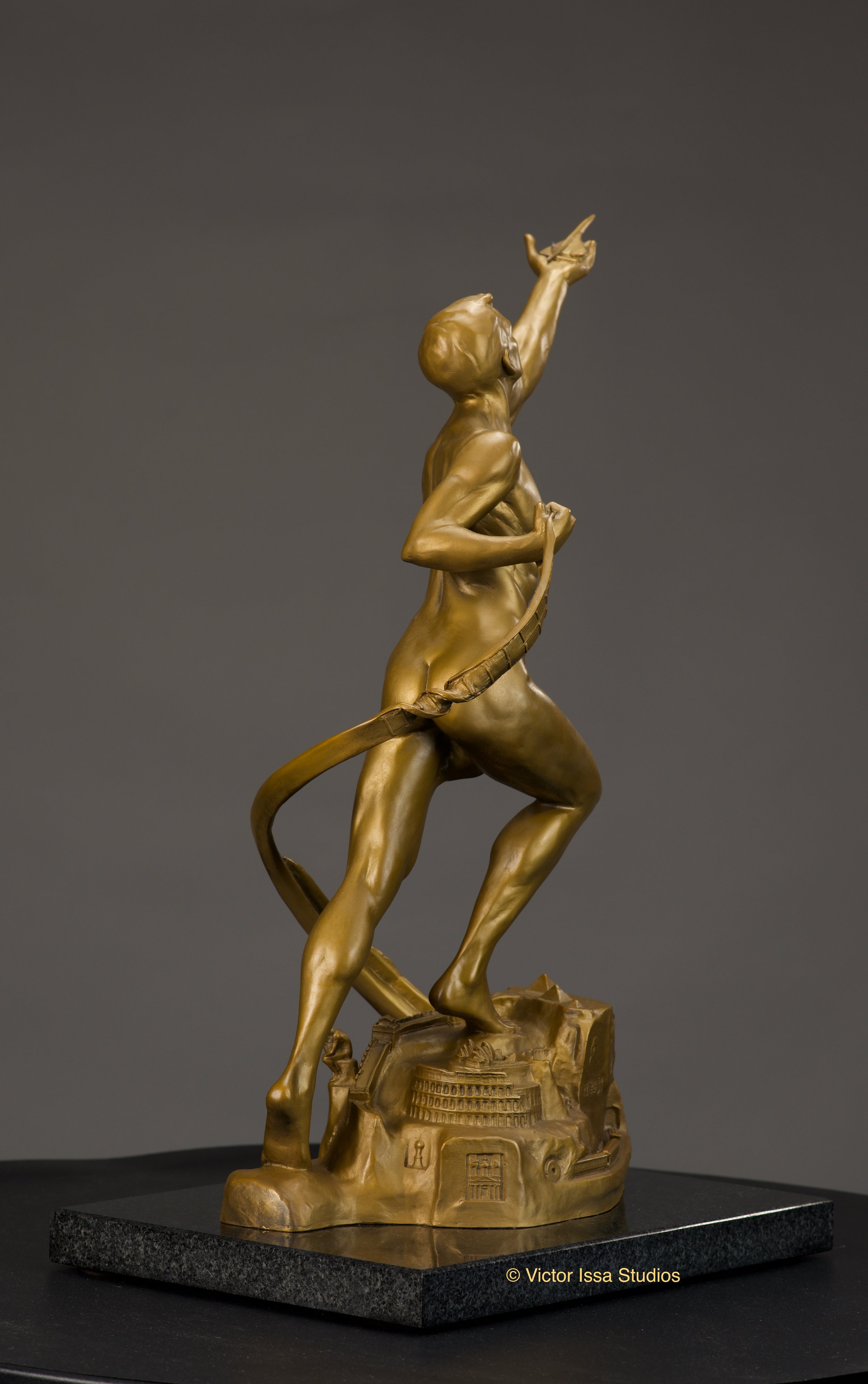
The Inspiration
The concept for “Power of Thought” was a result of years of reflection and study. Here is some of the research Victor Issa used to inform and inspire his art.
Structures Transportation Art Oil Printing Press Technology Space
Structures
Jordan's city of Petra, which was built more than 2,000 years ago, still fascinates visitors to this day. The Great Pyramid, or Khufu's Pyramid, in Egypt, still baffles the mind with its dimensions. And Sydney’s Opera House has come to represent an entire continent, not just a city or country. A grand project or an evolving technology, both were given birth by a single thought of a single individual.
A thought powered the building of an 8,851 km (5,500.3 mi) wall, the invention of the light bulb that turned night into day, and the seemingly simple transistor radio that eventually contributed to the computer/cell phone/internet technology that has changed the world we live in. A thought turned a nuisance black sticky substance into one of the most essential materials on Earth - turning goo into fabric, paint, fuel, medicine, and containers - saving millions of lives. A thought converted words into a storable object through the printed page which made possible the passing down and expansion of knowledge to every living being on this planet, turning the darkness of ignorance into the light of knowledge and understanding.
A writer assembles words together that change the rules of writing and continues to be quoted 400 years later.
Transportation
At some point, someone invented the wheel.
Locomotion remained limited to animal or human power until 1804 when Richard Trevithick, an English engineer, improved upon James Watts’ initial steam engine, and built the first full-scale model of a railway steam-powered locomotive.
Engineers from the United States and Germany began the race for “high speed” rail around the turn of the 20th century, reaching speeds of 90 mph in 1903. After World War II, Japanese transport needs combined with the dense population drove their engineers to travel to France to study the latest technologies. By 1963, the Shinkansen (Bullet Train) reached the speed of 159 mph (256 k/h) launching the modern high speed service for the masses.
And the speed continues to climb: in April of 2015, Japan’s Maglev broke its own previous record reaching the speed of 374 mph (603 km/h).
All through the power of thought.
Art
One of the New Seven Wonders of the World, the Taj Mahal, was commissioned in 1632 by Mughal emperor, Shah Jahan, to house the tomb of his favorite wife, Mumtaz Mahal.
The entire complex with the gardens and other buildings was completed in 1653. The shimmering white marble breathes the light of the sun in the daytime with transforming energy from sunrise to sunset. And the moonlight cascades across the intricate surfaces with its own magic.
Artists are often asked: “What is art for?” You could pose this question to the 8 million people who travel to see the Taj Mahal every year.
Perhaps it’s about seeking the transcending effect a fine work of art, a beautiful building, or even an exquisite flower arrangement can have on the human soul. Indeed, it is a priceless thing. For often, it serves no other purpose. Perhaps the transcending is one of the built-in memories in the human soul that reaches for the divine.
Oil
For thousands of years, crude oil that often bubbled to the surface at different locations around the globe was considered a little more than a nuisance. Primarily it was used for lighting, sealing (waterproofing), and as a bonding agent with some construction material. It wasn’t until the 1850s through the work of James Young, an English chemist, who thought through the process of separating the material into three components: light oil for light, viscus oil for lubrication, and a wax. Since then through the work of the mind, the substance is considered practically indispensable for human existence.
Rankin Energy provides a partial list of products made from Petroleum (there are over 6000 items).
One 42-gallon barrel of oil creates 19.4 gallons of gasoline. The rest (over half) is used to make things like:
Trash bags, house paint, water pipes, hand lotion, roller skates, surfboards, shampoo, wheels, paint rollers, shower curtains, guitar strings, luggage, aspirin, safety glasses, antifreeze, football helmets, awnings, eyeglasses, clothes, toothbrushes, ice chests, footballs, combs, CDs, paint brushes, detergents, vaporizers, balloons, sunglasses, tents, heart valves, crayons, parachutes, telephones, pillows, dishes, cameras, anesthetics, artificial turf, artificial limbs, dentures, model cars, folding doors, hair curlers, cold cream, movie film, fan belts, car enamel, bandages and SO MUCH MORE!
That’s quite a transformation - through the power of thought.
Printing Press
Throughout human history, knowledge was passed down mostly through the spoken word. Any written materials were produced by hand - one letter, one word, one page at a time. Then between the mid-1440s and 1480s, the equivalent of today’s internet exploded in Europe after Johannes Gutenberg created the first movable type press. Within those forty years, the presses multiplied and so did the number of available printed volumes causing a permanent shift in societal structures. The wide and open dissemination of ideas combined with the emerging entrepreneurial spirit threatened power structures and moved the world to new models of productivity and independence and produced the beginnings of a new economic class: the middle class.
Technology
I belong to a generation that preceded computing power. This means when I needed to research a topic, I had to go to the library, walk through shelves of volumes by categories, and skim through them in an attempt to find relevant information I can use in my pursuit. Research still requires a great deal of time. It has taken me many, many hours to build this site and fill it with relevant information. But it was all done while sitting in a chair, looking at a screen, and typing on a keyboard. The resources are simply at my fingertips. Three of the pivotal and transformative pieces of technology available today had their beginnings in the last century: computing, miniaturization, and the circuit board. I chose to represent this cluster with the inner electronics of a ‘60s Zenith transistor radio.
True, this element only represents two of the three and perhaps I’ll come up with a worthy and comprehensible depiction of the birth of the modern computer (as envisioned by the Alan Turing.) Turing was an English mathematician, computer scientist, cryptanalyst, and philosopher - along with other gifts and interests.
Miniaturization brought the tabletop radio to our pockets, the building size computer down to a pocket device with more computing power and reliability than the moon program used.
Space
“We choose to go to the moon in this decade and do the other things, not because they are easy, but because they are hard; because that goal will serve to organize and measure the best of our energies and skills, because that challenge is one that we are willing to accept, one we are unwilling to postpone, and one we intend to win, and the others, too.”
These words were spoken by John F. Kennedy on September 12, 1962 at Rice University that officially launched the moon project.
Over 400 years ago, Italian Astronomer Galileo used his simple telescope to look at the moon, noting the presence of mountains, craters and plains, and declaring it solid and can be walked upon.
In 1687 using mathematics, Isaac Newton theoretically calculated what speed a fired cannon shell would need to travel to obtain a continuous orbit 24,000 feet per second. It would need to travel faster than that to break free of Earth’s gravity. Impressive, considering the type of energy needed for such propulsive power would not exist for another 300 years.
In 1813, a British scientist worked out the rocket equation, which was confirmed by a Russian scientist in 1903.
In 1865, the French novelist Jules Vern imagined a journey to the moon by canon shot.
Inventor, engineer, and scientist Robert Goddard is credited for developing the liquid-fueled rocket with the first successful launch in 1926.
Rapid advancement of the rocket technology began in 1929 by German scientist, Wernher von Braun. Braun was captured after the war and led the development of rocket science in the United States through the 50s and early 60s.
On July 21, 1969, at 02:56:15 Greenwich Mean Time, Neil Armstrong was the first human to step onto the surface of another celestial body - our moon. This was the fruit of tens of thousands of individuals pouring hundreds of millions of hours and approximately 150 billion 2018 US dollars into this vision. But had President Kennedy not spoken those words in 1962, one might ask: “Would it have happened?”
“All that money could have gone to help so many people.” True. But let’s ask first: what was the real fruit of this pursuit?
Twenty percent of the globe’s population witnessed the landing (over 600,000,000). This means for the first time in Earth’s history, the aspirations and visions of a large portion of humanity were lifted upward at the same time.
There are literally thousands of technology transfers that were developed for the space program over the years that have enriched and saved lives. A quick internet search would lead you to simply too many to read in one afternoon. I’ll begin by dispelling a couple of persistent myths: Velcro and Tang are not on the lists, but here are a few samples that are: memory foam, improved firefighter’s breathing system, liquid-cooled garments, cordless tools, scratch-resistant lenses, sewage treatment with water hyacinths, heart defibrillator energy source, stereotactic breast biopsy technology, precision GPS software system, video image stabilization and registration (VISAR), automatic implantable cardioverter defibrillator, cochlear implant, light-emitting diodes (LED) for medical applications, atomic oxygen system for art restoration, wireless measurement acquisition system.
All happened through the power of thought.
Order Your Own Customized Sculpture

For scale, here is the monument-sized clay image of “Power of Thought” inside Victor Issa’s studio.

Victor chose the male figure to anchor his composition because throughout history men have innovated solutions such as trains, automobiles, computers, farming equipment, and more.
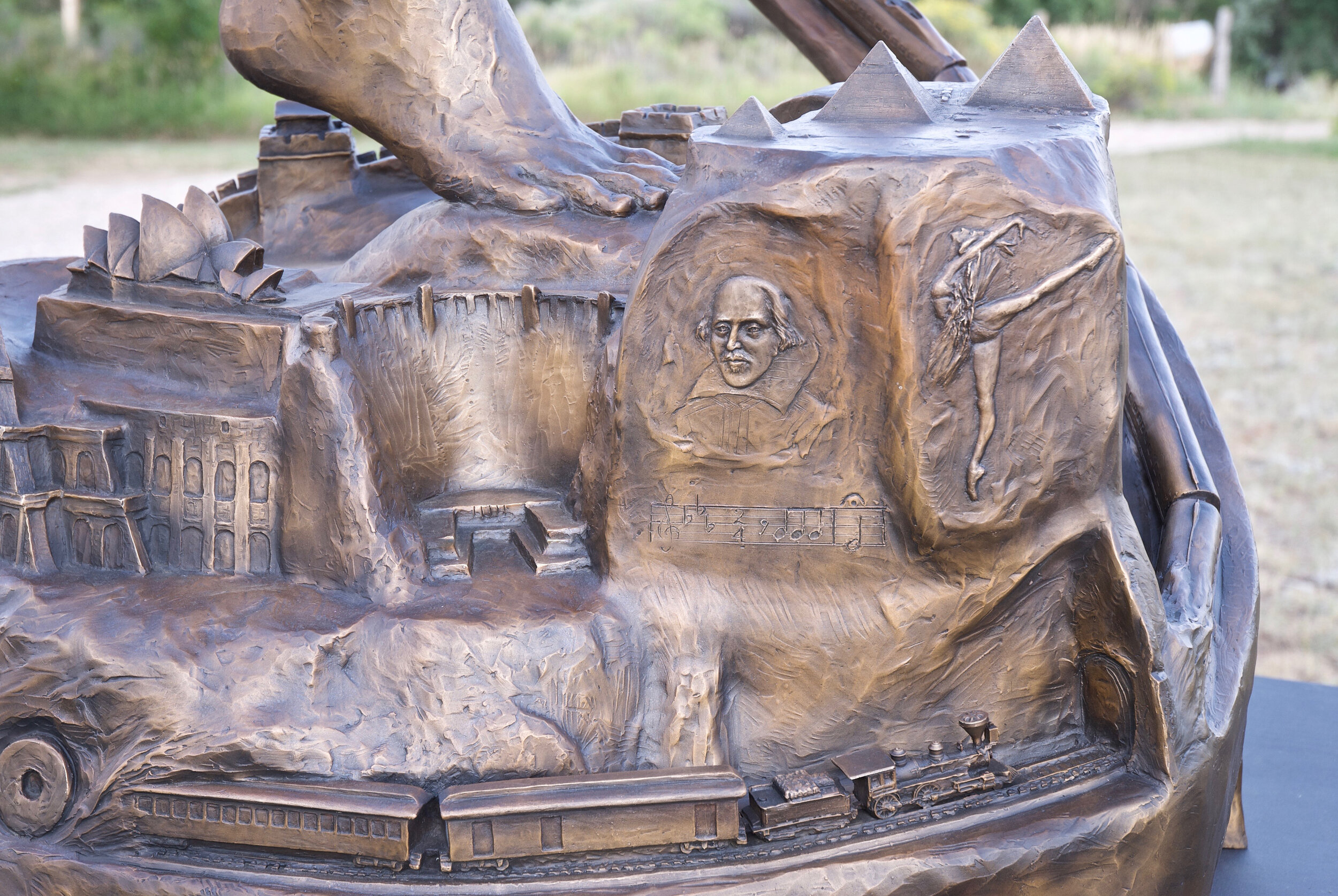
A wheel turns into a steam engine that becomes a bullet train. Architectural elements on this side of the sculpture include: The Roman Colosseum, Sydney’s Opera House, the Hoover Dam and Egypt’s pyramids. Artistic accomplishments represented here include Shakespeare, Swan Lake and Beethoven’s 5th Symphony.
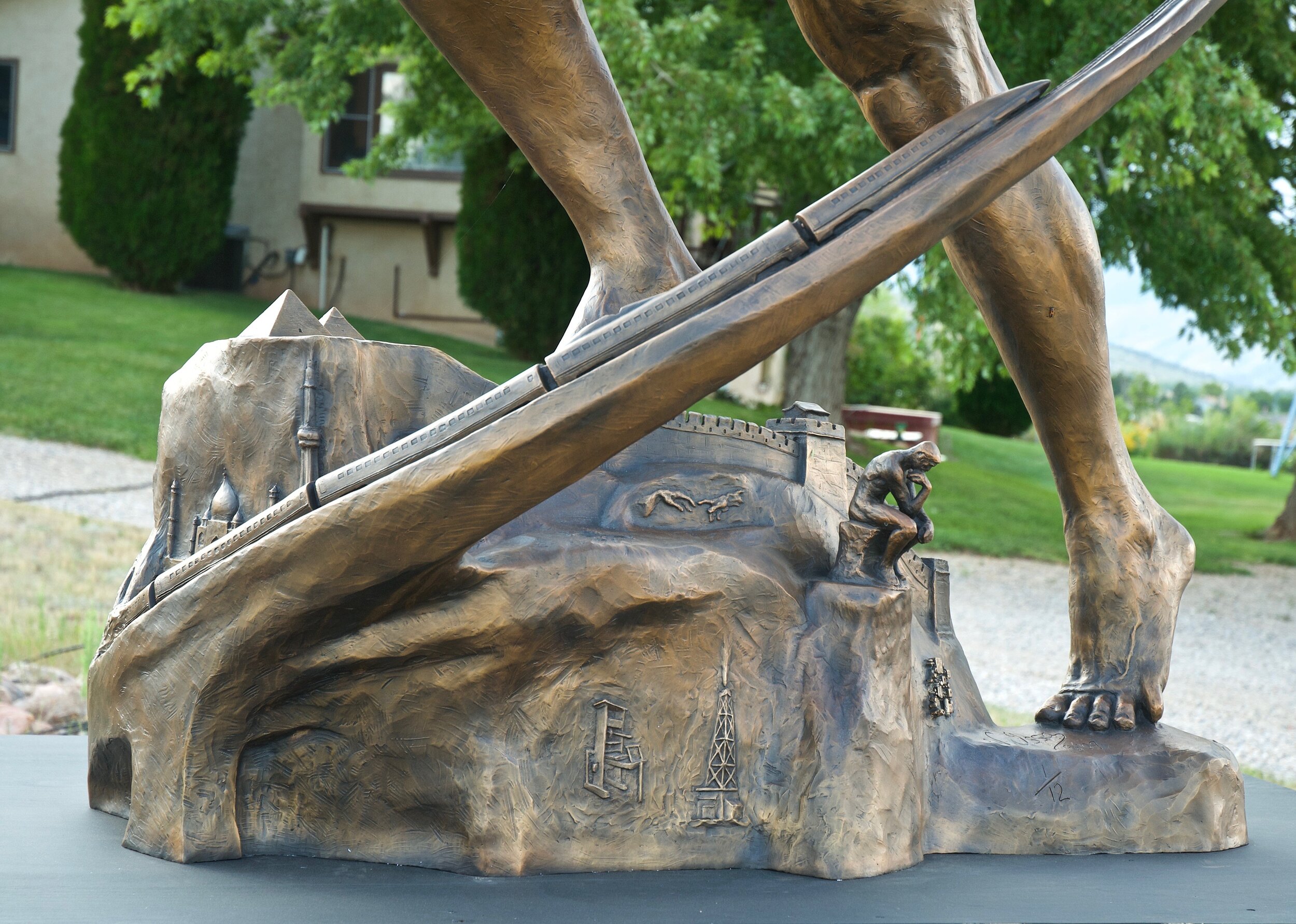
The bullet train, Michelangelo’s Creation of Adam from the Sistine chapel, and Rodin’s “The Thinker” are seen here. Below are the Gutenberg's press and an oil derrick.
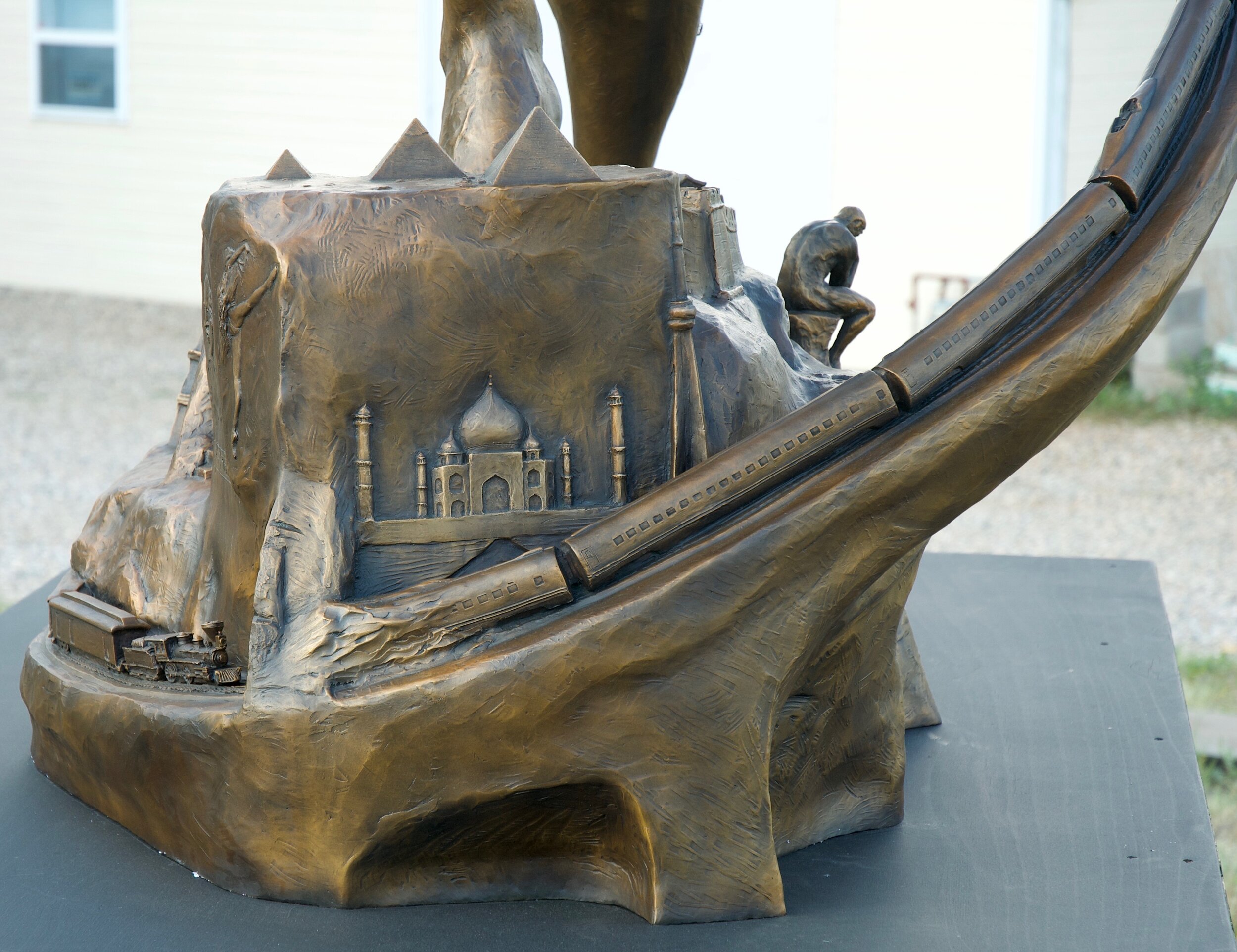
The Taj Mahal and Toronto’s CN Tower, along with another view of the pyramids, can be seen on this side of the sculpture’s base.

Neil Armstrong’s footprint on the surface of the moon.

A train track carrying a bullet train transforms into a DNA sequence, followed by the Wright brothers’ first flight, leading the way to supersonic transport.
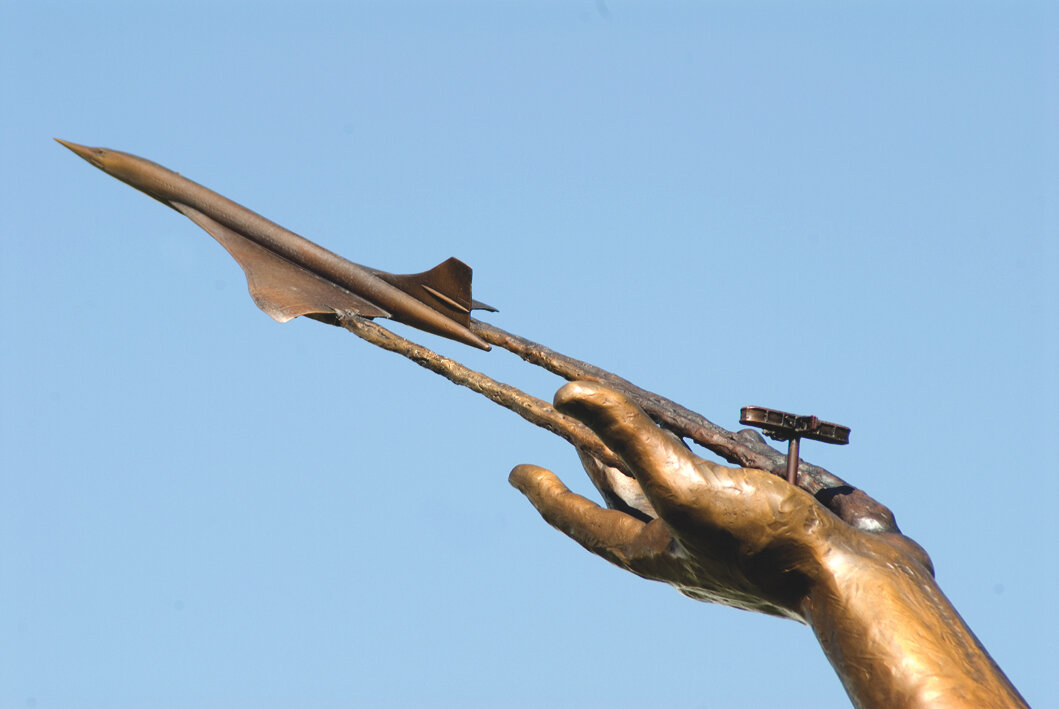
The revolutionary Wright Flyer led to the revolutionary supersonic transport, the Concorde.

A bronze plaque is included with every monument- or life-size order.

Our monument-size installation graces the facilities of the HudsonAlpha Institute for Biotechnology, located in Huntsville, Alabama. Huntsville is known as the Rocket City, and the institute is a nonprofit dedicated to developing and applying scientific advances to health, agriculture, learning, and commercialization. This sculpture was donated to the facility by one of the cofounders.
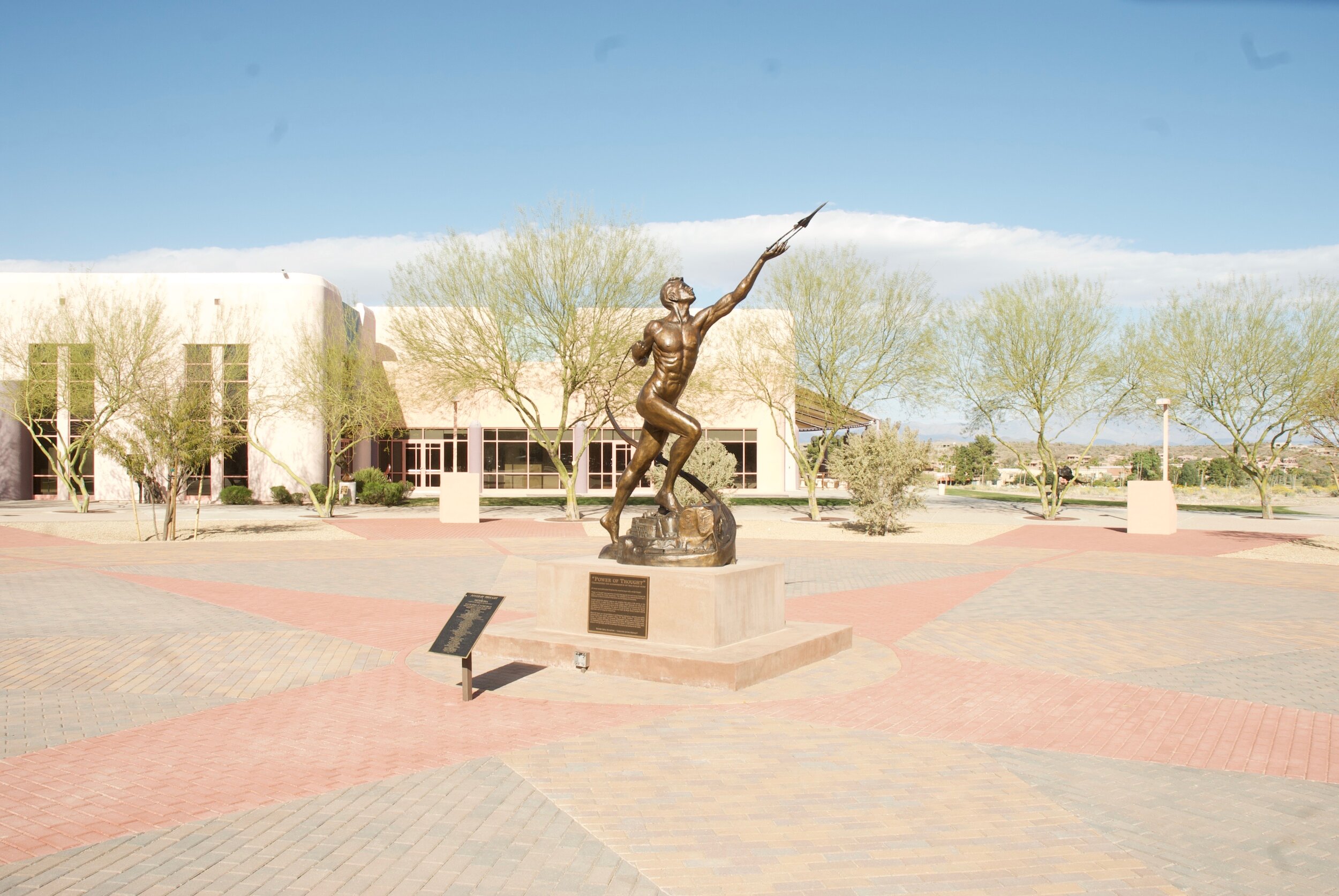
The second monument-size edition was installed as the centerpiece at the world-class sculpture gardens in Fountain Hills, Arizona, on the state’s centennial. This installation was funded by several prominent citizens of Fountain Hills.

The monument-size edition was installed at the Pioneer Technology Center in Ponca City, Oklahoma. The sculpture was donated to the Center by the late entrepreneur, inventor and businessman, Bill Bliss.
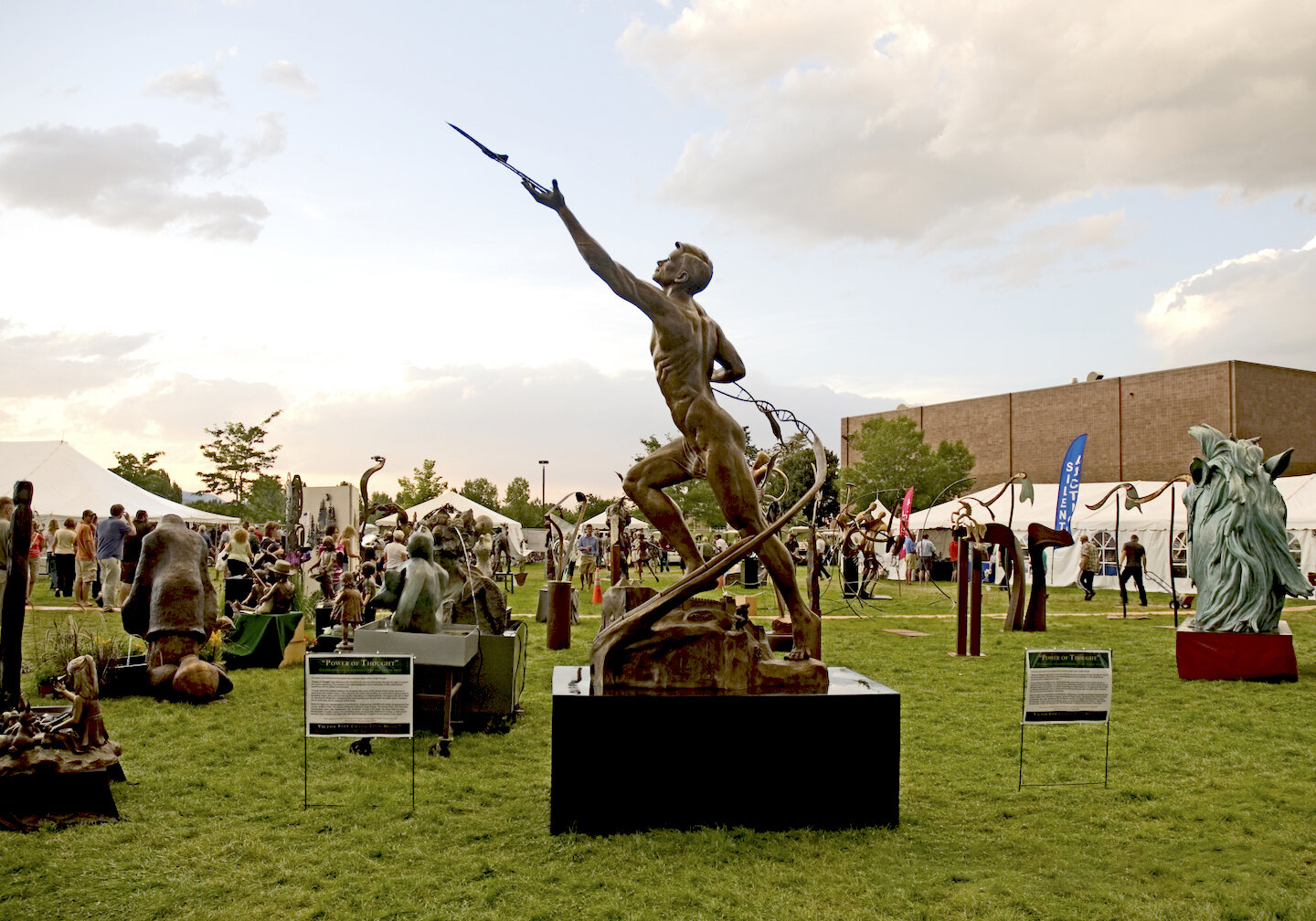
The great Loveland Sculpture Invitational Show & Sale featured thousands of sculptures annually from around the country, including the 10-foot version of “Power of Thought.”

A life-size edition graces the Peru State College campus, the oldest college in the state of Nebraska. This school has a proud history of producing leaders and accomplished graduates in many walks of life. Peru State College received this generous gift from one of its long-serving and beloved professors, Dr. Daryl Long, who also generously gifted a copy to his alma mater, North Iowa Area Community College.

The original study, the maquette-size is ⅓ of the life-size editions at 32-inches tall. It can be an equal source of inspiration and conversation within intimate settings at home, the office or a library.



In The Media
Victor Issa’s work has graced the pages of national magazines and news sites.
Best of Los Angeles Awards: 100 MOST FASCINATING PEOPLE IN LOS ANGELES (2021):
Victor Issa: One of the most talented figurative sculptors in America. On Facebook
“Victor Issa Creates Living Bronze” in Haute Living
“Creating Living Bronze” in The Blue Book
“The Sculptures and the Mission” by Loma Linda University Heath
“HudsonAlpha Celebrates ‘Power of Thought’” by Budd McLaughlin for Huntsville Times



